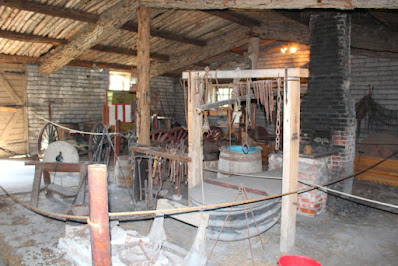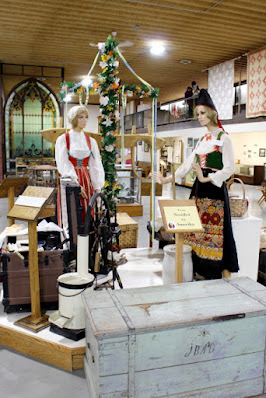There are two historic markers along US Highway 6 just west of Hastings (Nebraska) stating that the Oregon and Pony Express Trails passed this point on their way to the great Platte Valley.
One of the historic markers explains that in 1841 the first wagon train made the 2,000 mile journey over the Oregon trail. During the next twenty-five years a quarter of a million travelers passed this point. It required three months to make the journey from Missouri to Oregon because wagons could only travel 10-20 miles per day. Deep wagon ruts were left in the soil, but the ruts are no longer visible at this location.
The Pony Express ran from Missouri to California and used this part of the Oregon Trail. However, the Pony Express was short-lived and after only 18 months in operation it was replaced by the telegraph in 1861.
Pioneer Village in Minden (population 3,118) is a popular tourist stop along US Highway 6. The museum consists of 26 buildings that contain over 50,000 items. Included in the complex are antique cars, tractors, farm equipment, and an art collection.
As emigrants started migrating westward along the Oregon Trail, a series of forts were constructed to protect travelers. In 1848, Fort Kearny was the first fort established along the south side of the Platte River. As the fort expanded, added were a Pony Express way station, sentinel post, supply depot, and message center for westward bound travelers. A stockade was built on an earthen embankment that is still visible today. Although the troops were prepared for battle, the fort was never attacked by Indians.
None of the original fort improvements survived and then in 1962 the Fort Kearny stockade was reconstructed on the original site. Later a Visitor Center, Blacksmith/Carpenter Shop, and Powder Magazine were reconstructed. There are now walkways and site markers for the locations of 45 different improvements. On the site map it stated that there are plans to reconstruct the Officers' Quarters, Soldiers' Quarters', Soldiers' Kitchen, Adobe Storehouse, Warehouse (Barracks), Guardhouse and Prison, Commissary Warehouse, Quartermaster Warehouse, and Corrals.
A short distance west of Fort Kearny is the historic location of Dobytown. A historic marker states that Dobytown was developed near Fort Kearny
...in response to the thousands of soldiers, freighters and travelers whos "needs" could not be met within the fort. Gambling, liquor and disreputable men and women were its principal attractions. One of the town's most famous visitors, General William Tecumseh Sherman, described the horrible whiskey he was served here as "tanglefoot."
Located in the City of Kearney (population 33,790) is the Fort Kearney Museum (only open during the summer), Classic Car Collection (This is kind of a replacement for the Chevrolet Museum that was located just outside of Kearney but is now permanently closed), Trails & Rails Museum, and Nebraska Firefighters Museum & Education Center that is guarded by their fire dog R. Hero.
The Great Platte River Road Archway Monument spans Interstate 80 just east of Kearney. The Archway contains a high-tech multi-million-dollar multimedia presentation that tells the story of pioneers crossing the Nebraska plains on their way to California. President Bill Clinton visited the exhibit the first year it opened.
There are numerous bronze statues outside of the front entrance, including a statue of the Martin Brother that were pinned together by a Sioux Indian arrow.
I was surprised at the number of trains that pass through Kearney every day. Even more amazing was the observation that the train cars are well kept and there was almost no graffiti spray painted on the railroad cars.
Traveling west on the Lincoln Highway (US Hwy-30), and then south toward Holdrege, there was some interesting roadside art on display.
The Nebraska Prairie Museum north of Holdrege "has something for everyone!" This is a large museum and definitely worth a visit if anyone is ever in the area. Unfortunately, I only had time to visit the main building.
Included in the military exhibit was a room dedicated to the Atlanta WW II German POW Internment Camp that was located just south of Holdrege.
During WW II 70% of the male population in this area was serving in the military, so there was a lack of male workers on the "Home Front." Gasoline was rationed to three gallons per week, new automobiles & tires were manufactured for military use only, meat/sugar/coffee were strictly rationed, and no new civilian homes could be constructed. To solve the critical labor shortage, Atlanta POW Camp for German soldiers was constructed just south of Holdrege. There were also eighteen branch camps constructed throughout Nebraska and Kansas that were part of the Atlanta Camp. In total, nearly 100,000 German soldiers were processed through the Atlanta POW Camp on their way to various assignments.
Most of the German soldiers were friendly and willing to work for our side, so minimal US guards were required to watch them. The German soldiers were paid to work on farms, town jobs, and all types of construction projects. After the War, German POWs were allowed to return to United States if they had a sponsor. Since German soldiers had made so many friends while working for our side during the War, many Nebraskans sponsored the POWs, which allowed them to return and gain US Citizenship.
After leaving the Nebraska Prairie Museum I stopped by the Phelps County Courthouse in Holdridge (population 5,515) and the Gosper County Courthouse in Elwood (population 658). There was a nice War Memorial in front of the courthouse in Elwood.
Just south of Lexington, Highway 283 crosses the Central Nebraska Public Power and Irrigation District's 75-miile-long Central Supply Canal. Power boats that leave a wake are not allowed on the canal, but canoes and kayaks may use the canal for recreational purposes. Some portages are required over the 75-mile trip.
 |
| View East from a Bridge on Highway 283 |
 |
| View West From a Bridge on Highway 283 |



























































No comments:
Post a Comment